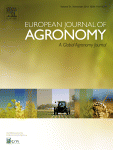Ver ítem
- xmlui.general.dspace_homeCentros Regionales y EEAsCentro Regional Santa FeEEA OliverosArtículos científicosxmlui.ArtifactBrowser.ItemViewer.trail
- Inicio
- Centros Regionales y EEAs
- Centro Regional Santa Fe
- EEA Oliveros
- Artículos científicos
- Ver ítem
Plant stand, nodulation and seed yield in soybean as affected by phosphate fertilizer placement, source and application method
Resumen
Establishing an optimum plant population at planting is the start-point for assuring seed yield in crops. In addition to plant establishment, the onset of a fully functional nodule system is crucial for nitrogen nutrition in soybean. Fertilizer application in close contact with seeds during planting operation would lead to phytotoxicity and plant loss. The objectives of the present study were to study the effects of two phosphate fertilizer sources:
[ver mas...]
Establishing an optimum plant population at planting is the start-point for assuring seed yield in crops. In addition to plant establishment, the onset of a fully functional nodule system is crucial for nitrogen nutrition in soybean. Fertilizer application in close contact with seeds during planting operation would lead to phytotoxicity and plant loss. The objectives of the present study were to study the effects of two phosphate fertilizer sources: single super phosphate (SSP) and monoammonium phosphate (MAP) (i) at increasing phosphorus rates applied with seed (WS) and (ii) using different fertilizer placement strategies on plant stand, seed yield and nodule onset. Two fertilization experiments in soybean (Experiments I and II) were performed in eleven sites in an ample area of the Argentinean soybean production area in 2005–2006 and 2006–2007 seasons (site-years, SY). Experiment I was designed for evaluating the effects of two P fertilizer sources (Sou): SSP and MAP combined with three methods of fertilizer application (Me): WS, side-banded (SB) or broadcast anticipated (BA) applying 16.2 kg P ha−1. Broadcast application was done at least 90 days before planting. Experiment II was planned for evaluating the above mentioned fertilizer sources at increasing P rates (0, 5.4, 10.8 and 16.2 kg P ha−1) applied with seed (WS). Fertilizer application with seed had less detrimental effect on plant stand achievement (PSA) when SSP was used as compared with MAP. Reductions in PSA were directly related with clay content when using both fertilizer source, but when using MAP, the decay in PSA was also negatively related to silt content. Broadcast as well as side-banded application of both fertilizer sources had no damaging effects on PSA. Seed yield response to fertilizer application was similar among different fertilizer placement strategies. In most cases, reduction in PSA did not affect seed yield, suggesting a high capacity of soybean to compensate plant loss. Nodule onset was severely affected by application of MAP with seed, but this was not translated in a reduced seed yield.
[Cerrar]

Fuente
European journal of agronomy 51 : 25-33. (November 2013)
Fecha
2013-11
ISSN
1161-0301
Formato
pdf
Tipo de documento
artículo
Palabras Claves
Derechos de acceso
Restringido
 Excepto donde se diga explicitamente, este item se publica bajo la siguiente descripción: Creative Commons Attribution-NonCommercial-ShareAlike 2.5 Unported (CC BY-NC-SA 2.5)
Excepto donde se diga explicitamente, este item se publica bajo la siguiente descripción: Creative Commons Attribution-NonCommercial-ShareAlike 2.5 Unported (CC BY-NC-SA 2.5)

